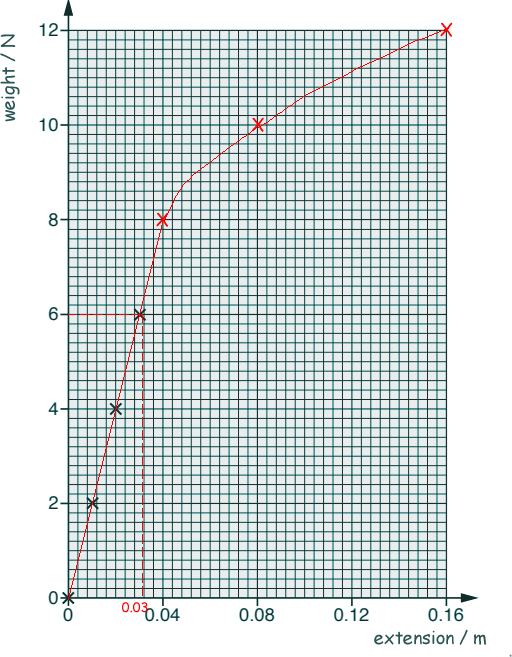GCSE Questions - Hooke's Law
Q3. Cordelia hangs a length of copper wire from the ceiling.
She adds weights to the bottom of the wire and measures the extension of the wire.
Look at a table of some of her results.
Weight (N) |
Extension (m) |
0 |
0 |
2 |
0.01 |
4 |
0.02 |
6 |
0.03 |
8 |
0.04 |
10 |
0.08 |
12 |
0.16 |
(a)
(i) Plot the values from Cordelia's experiment on the graph paper below.
(Some have been done for you).
All three points correctly plotted 
OR two points correctly plotted 
(2 marks)

(ii) Draw a line of best-fit on the graph.
You should draw a straight line up to 0.04, 8 (using a ruler to do so!) and continue the line with a curved line consistent with points plotted past this point. 
[1 mark]
(iii) Describe and explain the shape of the graph.
Initially the extension increases steadily/linearly/uniformly - it exhibits direct proportionally.  This corresponds to elastic behaviour in the wire and it is obeying Hooke's Law.
This corresponds to elastic behaviour in the wire and it is obeying Hooke's Law. 
Then after the wire reaches its elastic limit  the extension increases plastically and Hooke's Law is no longer obeyed.
the extension increases plastically and Hooke's Law is no longer obeyed. It stretches by a greater amount for each 2N weight added past this point.
It stretches by a greater amount for each 2N weight added past this point.
[4 marks]
(b) Calculate the spring constant for the 0 – 6N part of the graph.
The spring constant is the gradient of the straight line part of the graph.
k = F/x 
k = 6/0.03
k = 200  N/m
N/m 
[3 marks]
(c) Calculate the work done in stretching the wire to 0.04m.
work done = area under the graph line up to that point
½ x 8 x 0.04  = 0.16
= 0.16 J
J
OR using
E = ½FΔx
E = ½ x 200 x 0.042 
E = 0.16 J
J
[3 marks]
(Total 13 marks)







